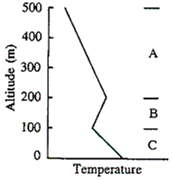The disadvantages of using oil shale and tar sands as energy sources include ____.
A. low net energy yield
B. severe land disruption
C. low potential supplies
D. release of carbon dioxide and other air pollutants when produced and burned
E. high water consumption
Answer: C
You might also like to view...
Mixing
Refer to the figure below.

A. in layer A B. above layer A C. in layer B D. in layer C
A population of quail lives in an area of prairie grasslands. In good years, a pair of quail can have four clutches of young, with as many as 12 to 14 eggs in each clutch. Despite this, the population size remains stable over the long term. Discuss the
population structure, its potential for growth, and its possible limiting factors, using at least four of the terms you learned in this chapter. What will be an ideal response?
Zooplankton populations in Lake Erie and the Hudson River have declined by up to 70% or more since the arrival of zebra mussels because ________
A) zebra mussels prey on zooplankton B) zebra mussels block sunlight penetration into lakes and thus prevent zooplankton from photosynthesizing C) zebra mussels carry a parasite that kills zooplankton D) waste from zebra mussels promotes bacterial growth that kills zooplankton E) zebra mussels feed on cyanobacteria, which zooplankton need as a food source
Despite many problems, since WWII steady efforts have been made toward European unification.
a. true b. false